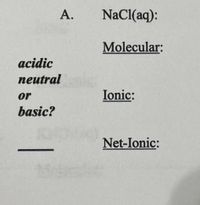
Chemistry
10th Edition
ISBN: 9781305957404
Author: Steven S. Zumdahl, Susan A. Zumdahl, Donald J. DeCoste
Publisher: Cengage Learning
expand_more
expand_more
format_list_bulleted
Concept explainers
Question
thumb_up100%
Hello, can you please solve this question and please show all your work. Thank you. Please figure out the molecular, ionic, and net-ionic equations. Also, if it's acidic neutral or basic?

Transcribed Image Text:NaCl(aq):
Molecular:
acidic
neutral
or
Ionic:
basic?
Net-Ionic:
A.
Expert Solution
This question has been solved!
Explore an expertly crafted, step-by-step solution for a thorough understanding of key concepts.
Step by stepSolved in 2 steps with 1 images

Knowledge Booster
Learn more about
Need a deep-dive on the concept behind this application? Look no further. Learn more about this topic, chemistry and related others by exploring similar questions and additional content below.Similar questions
- What is the molarity of a 0.92 M acid solution after four successive 1:4 dilutions? Enter your answer in scientific notation (example: 1.23E-2) with 3 significant figures and without units.arrow_forwardThe acidity of a solution is measured by its pH. If (T*] represents the concentration of hydrogen ions (in moles/liter) in the solution, the pH is defined by pH = – log Ht || Suppose a solution has pH = 1.98. (a) Rewrite the logarithmic form of the equation into exponential form. indicates two way equivalence) Click for List - ] – log H+ pH O Click for List Click for List (b) Find Ht, the approximate concentration of hydrogen ions. (Select one) O [H*]= 0.2967 moles/liter [H']~0.5051 moles/liter O [H*]= 0.01047 moles/liter O [H*]~ -0.2967 moles/liter O [H*]=0.03177 moles/liter [H*]= -95.4993 moles/liter O [H*]=3.3708 moles/literarrow_forwardWrite the net ionic equation, not only the molecular please. Also include the phases. HCl (aq) + HBr (aq)arrow_forward
- 人工知能を使用せず、 すべてを段階的にデジタル形式で解決してください。 ありがとう SOLVE STEP BY STEP IN DIGITAL FORMAT DON'T USE CHATGPT 2. Determine the concentration of hydrogen ions and hydroxide ions of the following solutions if known: a) pH= 1.5 b) pH = 2.2 c) pOH = 8.8 d) pOH = 9.5arrow_forwardIf the initial volume reading for the first titration was 0.16 mL and the final volume reading was 11.68 mL, what volume of iodine solution was used in your first titration (in mL)? Include the unit in your answer and two decimal places in your answer.arrow_forwardPlease don't provide handwriting solutionarrow_forward
- Nonearrow_forwardGive the correct chemical formulas of the products of an acid-base neutralization between H2SO4 and Al(OH)3. (Numbers will be assumed to be subscripts in your answer.) Do not try to enter any physical states or coefficients in the answer boxes. The order in which you list the products does not matter. Formula of one product (do not include the coefficient): Answer Formula of other product (do not include the coefficient): Answer What is the biggest coefficient in the balanced chemical equation for the reaction? (Report a single digit for your answer.) Answerarrow_forwardHow many milliliters of 1.6 M HCl are required to neutralize 50.0 mL of 0.20 M NaOH? Show all work and give your answer to three sig figs. HCl + NaOH → NaCl + H2Oarrow_forward
- Please help me. Thank you!arrow_forwardQuestions 1-4 refer to the same strong acid/strong base (SA/SB) titration. A 25.00 mL solution of 0.200 M hydroiodic acid (HI) is being titrated with 0.200 M sodium hydroxide (NaOH). What is the initial solution pH (when 0.00 mL of titrant have been added) (Two decimal places) Type your answer...arrow_forwardQuestions 1-4 refer to the same strong acid/strong base (SA/SB) titration. A 25.00 mL solution of 0.200 M hydroiodic acid (HI) is being titrated with 0.200 M sodium hydroxide (NaOH). What is the solution pH (when 15.00 mL of titrant have been added? (Two decimal places) Type your answer...arrow_forward
arrow_back_ios
SEE MORE QUESTIONS
arrow_forward_ios
Recommended textbooks for you
 ChemistryChemistryISBN:9781305957404Author:Steven S. Zumdahl, Susan A. Zumdahl, Donald J. DeCostePublisher:Cengage Learning
ChemistryChemistryISBN:9781305957404Author:Steven S. Zumdahl, Susan A. Zumdahl, Donald J. DeCostePublisher:Cengage Learning ChemistryChemistryISBN:9781259911156Author:Raymond Chang Dr., Jason Overby ProfessorPublisher:McGraw-Hill Education
ChemistryChemistryISBN:9781259911156Author:Raymond Chang Dr., Jason Overby ProfessorPublisher:McGraw-Hill Education Principles of Instrumental AnalysisChemistryISBN:9781305577213Author:Douglas A. Skoog, F. James Holler, Stanley R. CrouchPublisher:Cengage Learning
Principles of Instrumental AnalysisChemistryISBN:9781305577213Author:Douglas A. Skoog, F. James Holler, Stanley R. CrouchPublisher:Cengage Learning Organic ChemistryChemistryISBN:9780078021558Author:Janice Gorzynski Smith Dr.Publisher:McGraw-Hill Education
Organic ChemistryChemistryISBN:9780078021558Author:Janice Gorzynski Smith Dr.Publisher:McGraw-Hill Education Chemistry: Principles and ReactionsChemistryISBN:9781305079373Author:William L. Masterton, Cecile N. HurleyPublisher:Cengage Learning
Chemistry: Principles and ReactionsChemistryISBN:9781305079373Author:William L. Masterton, Cecile N. HurleyPublisher:Cengage Learning Elementary Principles of Chemical Processes, Bind...ChemistryISBN:9781118431221Author:Richard M. Felder, Ronald W. Rousseau, Lisa G. BullardPublisher:WILEY
Elementary Principles of Chemical Processes, Bind...ChemistryISBN:9781118431221Author:Richard M. Felder, Ronald W. Rousseau, Lisa G. BullardPublisher:WILEY

Chemistry
Chemistry
ISBN:9781305957404
Author:Steven S. Zumdahl, Susan A. Zumdahl, Donald J. DeCoste
Publisher:Cengage Learning

Chemistry
Chemistry
ISBN:9781259911156
Author:Raymond Chang Dr., Jason Overby Professor
Publisher:McGraw-Hill Education

Principles of Instrumental Analysis
Chemistry
ISBN:9781305577213
Author:Douglas A. Skoog, F. James Holler, Stanley R. Crouch
Publisher:Cengage Learning

Organic Chemistry
Chemistry
ISBN:9780078021558
Author:Janice Gorzynski Smith Dr.
Publisher:McGraw-Hill Education

Chemistry: Principles and Reactions
Chemistry
ISBN:9781305079373
Author:William L. Masterton, Cecile N. Hurley
Publisher:Cengage Learning

Elementary Principles of Chemical Processes, Bind...
Chemistry
ISBN:9781118431221
Author:Richard M. Felder, Ronald W. Rousseau, Lisa G. Bullard
Publisher:WILEY